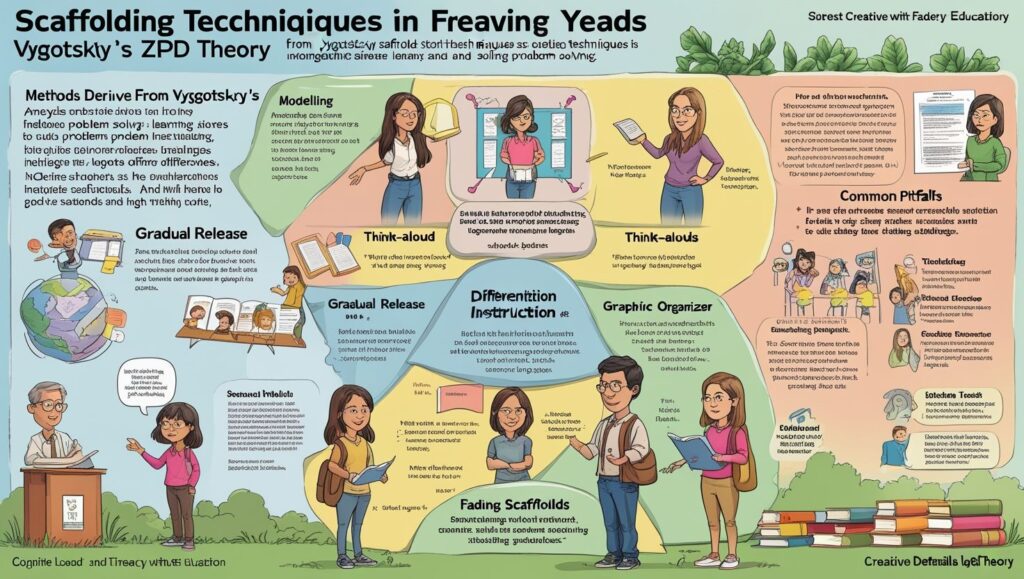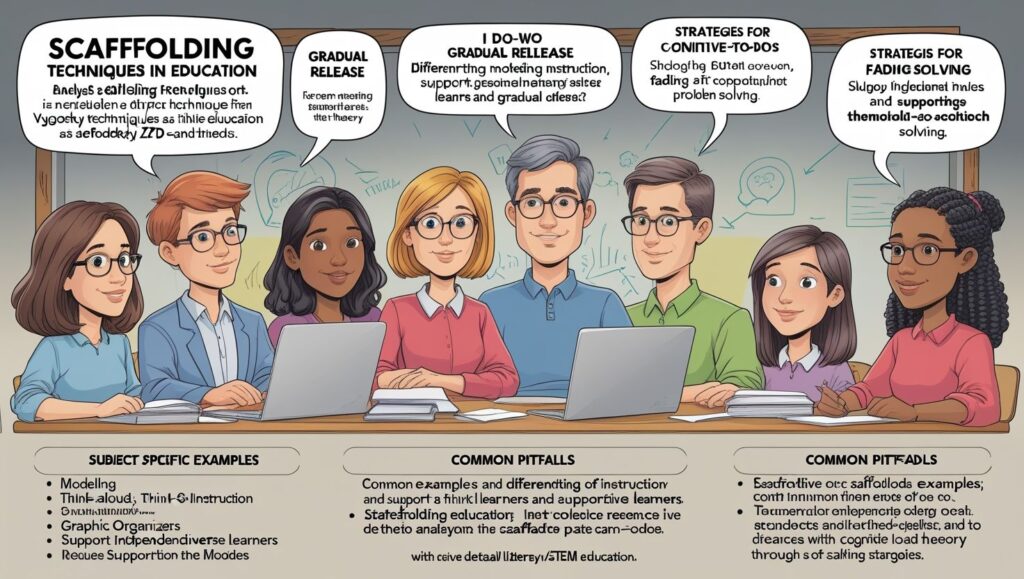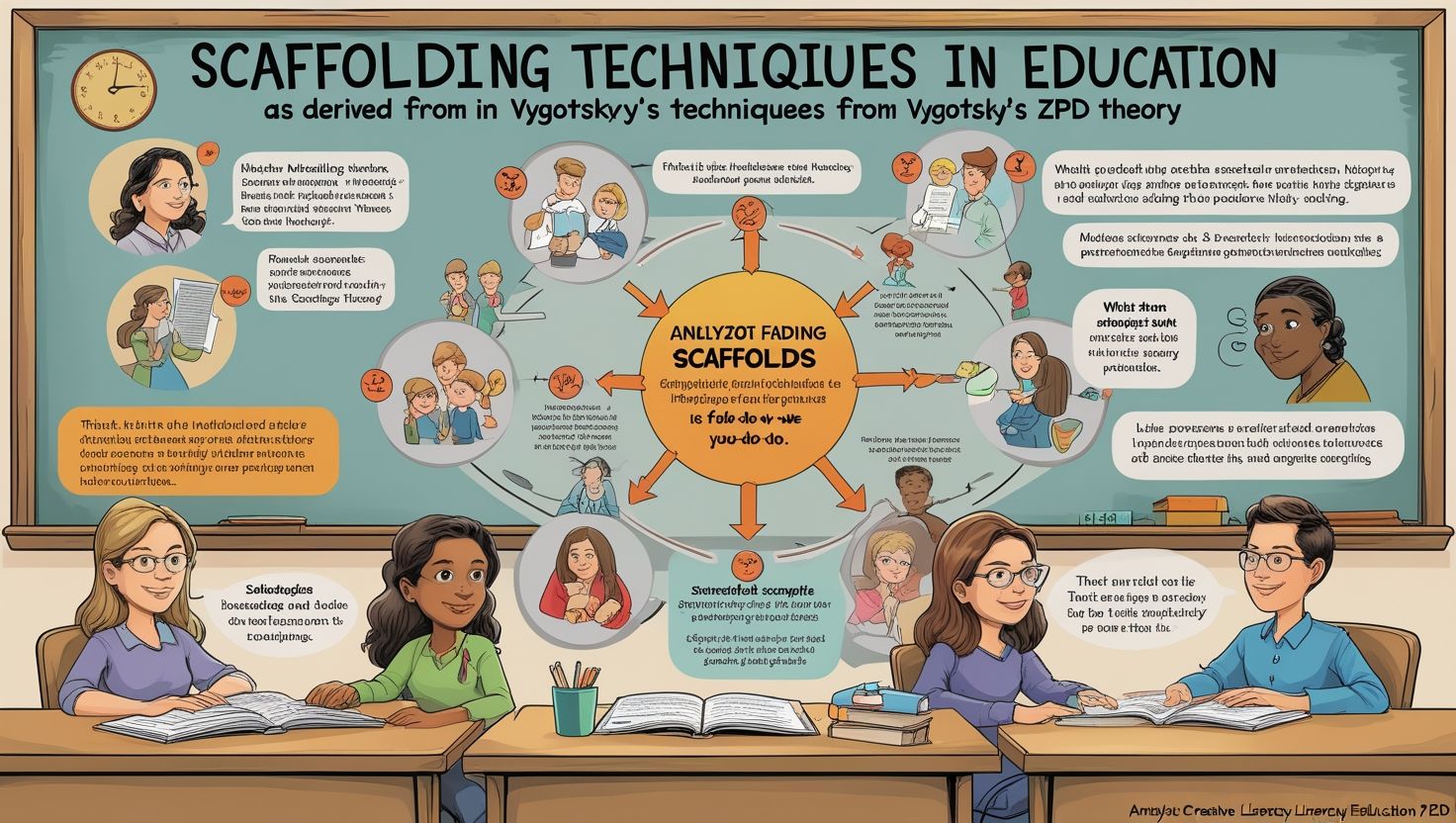Introduction
Scaffolding Techniques in Teaching, Scaffolding in education refers to the instructional strategies employed by educators to support student learning when new concepts and skills are being introduced. Coined by Jerome Bruner and rooted in the socio-cultural theory of Vygotsky, scaffolding provides a temporary structure to aid learners in reaching higher levels of understanding and skill acquisition. The metaphor draws from construction, where scaffolding temporarily supports a building under construction. Similarly, in teaching, scaffolds are gradually removed as learners gain independence. This article explores scaffolding techniques in teaching, their theoretical foundation, practical applications, benefits, and challenges.
Theoretical Foundations of Scaffoldin
Vygotsky’s Zone of Proximal Development (ZPD)
Lev Vygotsky, a Russian psychologist, introduced the concept of the Zone of Proximal Development, which refers to the difference between what a learner can do without help and what they can do with guidance. Scaffolding directly supports students in this zone, helping them perform tasks slightly above their current abilities with assistance, enabling skill and knowledge development.
Bruner’s Contributions
Jerome Bruner expanded on Vygotsky’s ideas and introduced scaffolding as a pedagogical concept. He emphasized discovery learning, where learners construct new ideas based on their current knowledge. The teacher’s role in scaffolding is to provide structured support that adapts to the learner’s progress, gradually removing assistance as competence increases.
Key Features of Scaffolding
Scaffolding is characterized by:
- Intentionality: Teachers have clear learning objectives.
- Appropriateness: Support is tailored to student needs.
- Graduated Support: Help is gradually reduced as competence grows.
- Collaboration: Learning occurs in a social context.
- Temporary Support: Assistance is removed once the learner gains proficiency.
Scaffolding Techniques in the Classroom
Educators can use various scaffolding techniques to enhance student learning. These strategies are not one-size-fits-all and must be adapted based on student age, ability, and subject.
1. Modeling
Modeling involves demonstrating a task or concept before students attempt it. Teachers verbalize their thinking process, helping students understand how to approach similar problems.
Example: In a writing class, a teacher writes an essay on the board, explaining each step—brainstorming, outlining, drafting, and editing.
2. Think-Alouds
This technique involves verbalizing thoughts while performing a task, helping students internalize cognitive processes.
Example: A math teacher solving a problem aloud might say, “First, I look at what is being asked. Then I identify the known values…”
3. Graphic Organizers
Visual tools like Venn diagrams, flowcharts, and concept maps help students organize information and see relationships between concepts.
Example: A history teacher might use a timeline to help students understand a sequence of events in World War II.
4. Use of Prior Knowledge
Connecting new content to what students already know makes learning more meaningful and accessible.
Example: In a science class about ecosystems, the teacher may begin by discussing students’ experiences with local parks or gardens.

5. Breaking Tasks into Smaller Steps
Complex tasks can overwhelm students. By segmenting them into smaller, manageable parts, learners can build confidence.
Example: In teaching essay writing, break it into choosing a topic, creating an outline, writing an introduction, and so on.
6. Guided Practice
After modeling a skill, the teacher guides students through practice with assistance before moving to independent tasks.
Example: Solving a few math problems together before asking students to complete a worksheet individually.
7. Prompting and Questioning
Socratic questioning helps students think critically and discover answers on their own, encouraging active learning.
Example: Instead of giving the answer, the teacher asks, “What do you think will happen if…?” or “Why do you think that is?”
8. Use of Analogies and Metaphors
Analogies relate complex concepts to familiar experiences, aiding comprehension.
Example: Comparing electricity flow in a circuit to water flowing in pipes to explain current and resistance.
9. Checklists and Rubrics
Providing clear expectations helps guide students through learning tasks and self-assessment.
Example: A writing rubric outlines criteria like clarity, grammar, structure, and coherence, helping students focus their efforts.
10. Peer Collaboration
Students can scaffold each other’s learning through discussions and group work.
Example: Pairing students to review each other’s work or solve problems together.
Benefits of Scaffolding Techniques
Scaffolding enhances the learning process in multiple ways:
1. Promotes Active Learning
Students are encouraged to participate, ask questions, and think critically, rather than passively receiving information.
2. Builds Confidence and Independence
Gradual removal of support leads to increased autonomy as students master tasks.
3. Supports Differentiated Instruction
Scaffolding allows teachers to cater to diverse learning styles, abilities, and paces within the same classroom.
4. Fosters Deeper Understanding
By building on prior knowledge and guiding students through complex concepts, scaffolding enhances comprehension and retention.
5. Encourages Collaboration
Group activities and peer support promote communication skills and shared learning responsibilities.
Scaffolding Across Educational Levels
Early Childhood Education
At this stage, scaffolding includes concrete visual aids, repetition, and play-based learning. Teachers might use storybooks, songs, and hands-on activities.
Example: Teaching the alphabet by singing and pointing to letters on a chart.
Elementary Education
Teachers focus on breaking down academic tasks and using interactive activities.
Example: Using story maps in reading to help children understand narrative structure.
Secondary Education
Students are more capable of handling abstract ideas. Teachers can use graphic organizers, guided debates, and independent research projects with partial guidance.
Example: In science, students may conduct experiments with initial guidance on the scientific method.
Higher Education
Professors offer minimal but strategic scaffolding. Techniques include seminar discussions, case studies, and research mentorship.
Example: A professor guiding students through a research proposal by offering feedback at each stage.

Challenges in Implementing Scaffolding
While scaffolding is beneficial, it also presents certain challenges:
1. Time-Intensive
Effective scaffolding requires careful planning and more instructional time than traditional lecture methods.
2. Assessment Complexity
It may be difficult to assess individual learning progress when students work collaboratively or with teacher assistance.
3. Risk of Over-Scaffolding
Providing too much support may hinder independence and discourage problem-solving.
4. Teacher Expertise Required
Scaffolding demands skill in recognizing the ZPD of each learner and adjusting support accordingly.
5. Student Dependency
If not gradually removed, scaffolding may lead to reliance on the teacher or peers.
Strategies to Implement Scaffolding Effectively
To implement scaffolding successfully, teachers should:
1. Know the Learner
Understand student readiness, interests, and prior knowledge to tailor support effectively.
2. Set Clear Learning Goals
Define what students should know and be able to do at the end of the lesson.
3. Plan Structured Activities
Use lesson plans that allow for modeling, guided practice, and independent application.
4. Use Formative Assessments
Ongoing assessments help monitor student progress and determine when to adjust or remove scaffolds.
5. Encourage Reflection
Encourage students to think about their learning process, which promotes metacognition and deeper understanding.
6. Provide Timely Feedback
Constructive feedback helps students correct errors and stay on track without becoming discouraged.
Examples of Scaffolding in Different Subjects
Mathematics
- Scaffold: Use base-ten blocks to teach place value.
- Support: Start with hands-on manipulation, move to drawing representations, then abstract symbols.
English Language Arts
- Scaffold: Read a text aloud, discuss themes, annotate together.
- Support: Provide vocabulary lists, graphic organizers, and writing frames.
Science
- Scaffold: Conduct a guided experiment.
- Support: Provide step-by-step instructions and a lab report template.
Social Studies
- Scaffold: Use primary sources with guiding questions.
- Support: Offer historical context and vocabulary support.
Technological Scaffolding
Technology can also play a vital role in scaffolding learning:
1. Interactive Software
Programs adapt to student performance, offering hints and tutorials (e.g., Khan Academy, Duolingo).
2. Online Collaboration Tools
Platforms like Google Docs allow real-time feedback and peer collaboration.
3. Learning Management Systems
Teachers can structure courses into modules with embedded support (videos, readings, quizzes).
Conclusion
Scaffolding is a powerful instructional technique rooted in cognitive and social learning theories. By providing the right amount of support at the right time, teachers enable students to build confidence, master complex concepts, and become independent learners. Effective scaffolding requires planning, adaptability, and an understanding of student needs. As educational landscapes continue to evolve, particularly with technological advancements, the principles of scaffolding remain central to effective teaching and meaningful learning. When used thoughtfully, scaffolding transforms classrooms into dynamic environments where all students can succeed.
References
- Vygotsky, L. S. (1978). Mind in Society: The Development of Higher Psychological Processes. Harvard University Press.
- Bruner, J. S. (1966). Toward a Theory of Instruction. Harvard University Press.
- van de Pol, J., Volman, M., & Beishuizen, J. (2010). Scaffolding in teacher–student interaction: A decade of research. Educational Psychology Review, 22(3), 271–296.
- Hogan, K., & Pressley, M. (1997). Scaffolding Student Learning: Instructional Approaches and Issues. Brookline Books.
- Wood, D., Bruner, J. S., & Ross, G. (1976). The role of tutoring in problem solving. Journal of Child Psychology and Psychiatry, 17(2), 89–100.
- Hammond, J., & Gibbons, P. (2005). Putting scaffolding to work: The contribution of scaffolding in articulating ESL education. Prospect, 20(1), 6–30.

testosterone trenbolone dianabol cycle
References:
test and dianabol cycle (skitterphoto.com)
Hi! Someone in my Myspace group shared this
site with us so I came to look it over. I’m definitely
enjoying the information. I’m book-marking and will be tweeting this to my followers!
Exceptional blog and amazing design.
Attractive section of content. I just stubled upon your weblog
aand in accession capital to assert that I acquire achtually enjoyed account
your blog posts. Any way I’ll bee subscribing to your feeds and even I achievement
you access consisstently fast. https://bookofdead34.Wordpress.com
Your prose carries gentle resonance, producing contemplative rhythm. Each phrase encourages lingering, reflection, and mindful engagement, allowing insight, subtlety, and emotional depth to emerge naturally.
This is wonderful about the article. The process and techniques of scaffolding are valuable and benefiting for understanding the children and to manage it as well. The targeted people, especially the teachers, parents and children would be benefitted from the article and the consequence goes for the development of the children. Whether the reader feels interested, there are some other process and techniques of the same area: https://explorer-bd.com/how-teachers-can-scaffold-a-childs-learning/